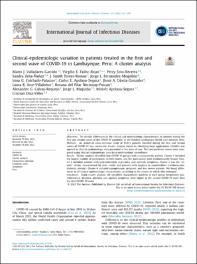Clinical-epidemiologic variation in patients treated in the first and second wave of COVID-19 in Lambayeque, Peru: A cluster analysis

View/
Download
(application/pdf: 1.787Mb)
(application/pdf: 1.787Mb)
Date
2022-07-18Author(s)
Valladares-Garrido, Mario J.
Failoc-Rojas, Virgilio E.
Soto-Becerra, Percy
Zeña-Ñañez, Sandra
Torres-Roman, J. Smith
Fernández-Mogollón, Jorge L.
Colchado-Palacios, Irina G.
Apolaya-Segura, Carlos E.
Dávila-Gonzales, Jhoni A.
Arce-Villalobos, Laura R.
Neciosup-Puican, Roxana del Pilar
Calvay-Requejo, Alexander G.
Maguiña, Jorge L.
Apolaya-Segura, Moisés
Díaz-Vélez, Cristian
Metadata
Show full item recordAbstract
“Objectives: To identify differences in the clinical and epidemiologic characteristics of patients during the
first and second waves of the COVID-19 pandemic at the EsSalud Lambayeque health care network, Peru.
Methods: An analytical cross-sectional study of 53,912 patients enrolled during the first and second
waves of COVID-19 was conducted. Cluster analysis based on clustering large applications (CLARA) was
applied to clinical-epidemiologic data presented at the time of care. The two pandemic waves were compared using clinical-epidemiologic data from epidemiologic surveillance.
Results: Cluster analysis identified four COVID-19 groups with a characteristic pattern. Cluster 1 included
the largest number of participants in both waves, and the participants were predominantly female. Cluster 2 included patients with gastrointestinal, respiratory, and systemic symptoms. Cluster 3 was the “severe” cluster, characterized by older adults and patients with dyspnea or comorbidities (cardiovascular,
diabetes, obesity). Cluster 4 included asymptomatic, pregnant, and less severe patients. We found differences in all clinical-epidemiologic characteristics according to the cluster to which they belonged.
Conclusion: Using cluster analysis, we identified characteristic patterns in each group. Respiratory, gastrointestinal, dyspnea, anosmia, and ageusia symptoms were higher in the second COVID-19 wave than
the first COVID-19 wave“
Collections
- Web of Science (WOS) [236]

